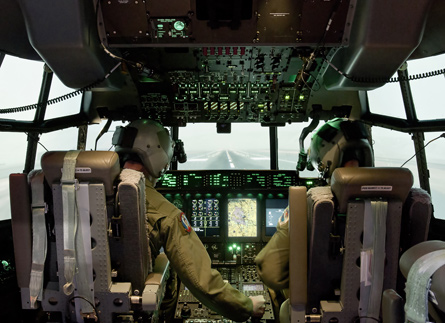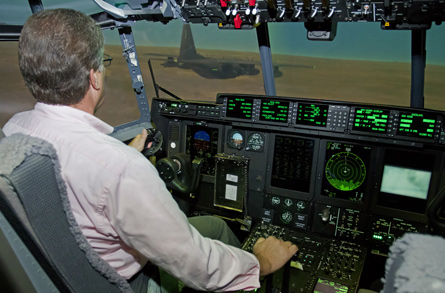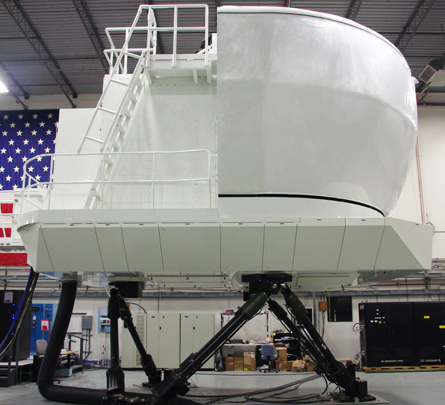During my career as a pilot in the US Air Force the Lockheed Martin C-130 made meaningful cameo appearances. As a parachute-qualified forward air controller, I jumped from, and received my Jumpmaster qualification in, a C-130. When I studied at the US Air Force test-pilot school, the performance phase check ride was administered in the same type.
I have been a Flight International test pilot since 1999, and a C-130J was one of my first subjects. Two years later I flew a CAE produced C-130J operational flight trainer, then undergoing acceptance trials before shipment to the Italian Air Force's National Training Center, near Pisa.
 |
|---|
© Lockheed Martin The cockpit includes stations for two pilots |
Recently, Flight International was invited to CAE's Tampa, Florida, facility to sample the first HC/MC-130J weapons system trainer (WST), developed as part of the C-130J Maintenance & Aircrew Training System programme by Lockheed Martin for the air force. The WST is a full-flight simulator with five trainee stations.
The C-130J is the only type for which I have flown both the aircraft and the simulator for Flight International. At the time I remarked, "The simulator felt like the real aircraft." But with 10 years passing since my last C-130J "flight", how would the experience now compare, given advances in flight simulators?
MODEL DIFFERENCES
While a derivative of prior Hercules, the J model features upgraded avionics and more powerful propulsion. The flightdeck is optimised for two-pilot operations, and dispenses with legacy navigator and flight-engineer positions. The J's four Rolls-Royce Allison AE2100D3 turboshaft engines each drive a six-blade Dowty R391 propeller. The J has up to 25% more thrust at sea level than a C-130H.
The C-130J I flew in Georgia was a standard-length air force version. The UK's Royal Air Force has fielded a mix of standard Js and 4.57m- (15ft)-longer -30 variants. The WST I would be flying was an HC/MC-130J. The "HC" is a search and rescue variant, dubbed "Combat King II". The "MC" is a special-operations variant, dubbed "Combat Shadow II". Both the MC and HC are based on the short model KC-130J variant operated by the US Marine Corps.
From a systems standpoint, the major additions to the baseline KC-130J model are a boom air-refuelling receptacle, an electro-optical infrared (EO/IR) sensor suite, an enhanced cargo handling system and larger-capacity electrical generators. Wing-mounted drogue-refuelling pods are carried over from the KC-130J. On the flightdeck, a dual combat systems operator (CSO)/auxiliary crew station has been added. The CSO position features three colour multipurpose display units.
 |
|---|
© Lockheed Martin Michael Gerzanics: a C-130 veteran |
The 32,500lb (15,000kg) cab of the simulator is relatively large, as it has stations for two pilots, a dual CSO/auxiliary station and a loadmaster, as well as three instructor stations. The cab sits atop a CAE "True" electric motion system. Produced in conjunction with Moog, the motion system is state of the art.
The electric system has approximately one-quarter the power consumption of a comparable hydraulic actuation system, as well lower maintenance costs. Green advantages are not limited to its reduced power requirements. The simulation facility can be smaller, as a hydraulic power unit room is not required, and there is no hazardous hydraulic fluid to deal with.
The out-of-window visual imagery and sensor images are generated by a FlightSafety International VITAL X system. For the HC/MC-130J, five LCoS (liquid crystal on silicon) projectors yield a 200e_SDgr x 50e_SDgr visual field of view (FoV) with 15.5 million displayed pixels. The high-definition imagery can have resolution as low as 25mm, with a total gaming area of up to 36 million hectares.
Three EO/IR channels provide imagery for the HC/MC-130J's turret-mounted EO/IR system. The WST and visual display are also night-vision goggle (NVG) compatible, essential for special operations and rescue training. For NVG work the five main visual projectors' output intensity is reduced to very low level, so the NVG FoV is the same as the normal visual one. The VITAL X system is a capable one, on par with commercial simulator display systems I have sampled. But where it shines is in commonality. FlightSafety has delivered hundreds of VITAL X systems to the US military, reducing database development costs.
For my preview flight, I was accompanied by two CAE Pilots. Programme manager and pilot Rick Wynn, a former USAF F-16 pilot, sat in the right seat. Ricard Smith ran the simulator from the instructor/operator station. Smith had flown C-130s for 20 years, as well as being an instructor for more than seven.
Once seated in the left-hand seat, I adjusted its height to gain a full view of the wide FoV head-up display (HUD). One unique aspect of the J programme was that it was certificated to civil US Federal Aviation Administration standards, the HUD functioning as primary flight displays (PFDs). In addition to the HUD, five 150 x 200mm CDMUs are housed on the forward panel. Normally the outboard CDMU is used to display a map, but with the press of a yoke switch, it can be shifted to a conventional PFD. Most HUDs I have flown use tape displays for speed and altitude. The J's HUD utilised round-dial speed and altitude displays, a format I initially found confusing.
The initial simulator set-up had the J at the end of the runway with engines running. Take-off was accomplished with flaps set to 50%. Take-off data was computed using the centre console-mounted communication, navigation, identification management unit.
I used the left sidewall-mounted tiller to stay on centreline as the rudder pedals do not control the nosewheel steering. Accelerating through 60kt (110km/h) indicated airspeed, the rudder became effective and I released the tiller and took control of the yoke. At 104kt Wynn called "rotate" and a moderate pull on the yoke was needed to establish a 10e_SDgr nose-high climb attitude. During acceleration to the climb speed of 200kt, pitch changes caused by gear and flap retraction were easily countered by the pitch trim. I hand-flew the J to 5,000ft (1,500m) MSL and once level, set power to hold 200kt.
SYNTHETIC GAS
During my prior C-130J simulator flight, I was able to try my hand at probe and drogue refuelling. In that session the tanker was a Vickers VC10, and while I was able to close and maintain position on it, I was unable to spear the basket. The J I was flying now had boom-refuelling receptacle, a method I had used many times. In daylight conditions, Smith placed a KC-10 about 1,000m in front of the J. Using purely visual references I could join on the KC-10 and stabilise in pre-contact position.
I slowly worked the J closer to the tanker and stabilised in the contact position. The simulated tanker closely matched the real tankers from which I have refuelled, but it could have been a bit more detailed. For example, the belly-mounted director lights - used to help gain and maintain the proper refuelling position - were not sharp enough for my liking. While the visuals would not be mistaken for a real scene, there was enough texture to maintain the desired refuelling position.
 |
|---|
© Lockheed Martin The simulator was tested at a CAE facility |
The aerodynamics model near the tanker also seemed fairly real. With a connection to the boom, drifting high or outboard towards the engines placed the J in the KC-10's wake and produced a noticeable airframe buffet. While it has been years since I air-refuelled an aircraft, behind the KC-10 I was able to precisely maintain the desired position. After disconnecting, Smith replaced the trijet with a smaller KC-135. Like the KC-10, the KC-135 visual had enough detail to provide a valuable training aide. As with the KC-10, I was easily able to gain and maintain the pre-contact position. While level with the boom, I slowly closed on the KC-135. Approaching the contact position, the J's tail encountered jet wash from the KC-135 and started a yawing motion which I could not stop. Smith said that was not uncommon for neophyte receiver pilots.
A slight reduction of power allowed the J to slide aft and further below the tanker, where the unwanted yawing motion stopped. Next, I approached the contact position from aft and below. As I had done while flying F-111s and F-16s, I used a lateral stripe and radio antenna on the KC-135's belly as a visual approach slope indicator to reach the contact position.
This time I could stabilise for several moments, but shortly after boom contact I drifted laterally into the jet wash. Gentle yawing motions were again excited, forcing me to back out to the pre-contact position. While I cannot say if the wake generated by the virtual KC-135 accurately modelled the real world, I certainly worked up a sweat trying to take gas from the Stratotanker. My overall impression was that the HC/MC-130J WST would be an excellent platform to teach air-to-air refuelling procedures and techniques, but I would hesitate to recommend signing off a student for unsupervised refuelling-based WST training.
After completion of the air-refuelling tasks, we descended to 1,000ft above ground level for a simulated cargo drop. On slowing to 140kt, the ramp was lowered ready to drop a 42,000lb pallet and 15s prior to the release point, the drogue chutes - attached to the cargo pallet and a tow plate on the J's cargo compartment floor - were deployed. At "green light" the tow plate was released, allowing the drogue chutes to deploy the three main chutes. A large forward yoke input was needed to keep the J from pitching into a stall as the main chutes pulled the 21-tonne load clear of the ramp.
NIGHT-TIME CONDITIONS
After completing the cargo drop, Smith set night-time conditions for a quick evaluation of the night scene. Capability allows for continuous-time-of-day tracking of the moon across the sky, and for the moon model to change phases. No NVG-equipped helmets were available for our session, so Wynn flew the J as I used a hand-held pair to survey the night scene. While NVGs compromise depth perception, I found the WST's scene provided enough texture to allow for low-altitude night operations. While not evaluated during my flight, the environmental database is programmed with night-vision corridors.
These corridors have a finer resolution than the surrounding terrain, allowing for more realistic training. Using NVG corridors, different moon phases, angles and ambient lighting can be selected for more detailed low-level training. The J's ground-mapping radar and turret mounted EO/IR are two additional systems that make the HC/MC-130J a capable nighttime machine. The J also has a terrain awareness and warning system.
Smith turned the lights up slightly and slewed the J to a final-approach position for an assault landing at Little Rock AFB. The end of the 60ft x 3,500ft runway, lit by white lights, was clearly visible at night. With full flaps set, I used the J's large HUD to fly a 2.5° glide path to the assault strip. Speed over the threshold was only 101kt (indicated airspeed) and slight flare allowed the J to touchdown at about 95kt. A combination of wheel braking and reverse thrust brought the J to a stop in less than 500m from the threshold.
Next, Wynn set the flaps to 50% for a maximum effort take-off. I held the wheelbrakes and rapidly advanced the throttles, the full-authority digital engine controls setting the maximum allowed 4,700shp (3,500kW). After brake release the J rapidly reached a V rotate of 80kt, and leapt off the strip well prior to the departure end. Once airborne, Smith froze the simulator and slewed the J to Kirtland AFB (KABQ) in Albuquerque, New Mexico.
The last event flown in the WTS was some formation work with another C-130J. In daylight conditions Smith placed the J on KABQ's Runway 08 for a formation take-off. The lead aircraft took off, with us rolling 30s later. Once airborne we joined on the lead aircraft to a "fingertip" position. I found the WST's visual scene provided enough references for accurate station-keeping during gentle manoeuvres. Next, I slid aft and outboard of the lead J to simulate a para-drop formation. Smith said the circle of the HUD's airspeed indicator was handy for maintaining desired distance from the lead J. When the lead aircraft's wingtips touched the edges of the circle, we were at the desired 610m trail position.
In simulator usage, armed forces have lagged their civil counterparts, but it has become more common, especially in initial qualification (IQ) phase training. The air force performs nearly all its C-130J IQ training in the Level D-comparable WST. But military aircrews must also learn to employ weapons systems. The high operational tempo of the C-130, coupled with budgetary constraints, has created demand for a capable WST.
My preview flight in the HC/MC-130J WST showed that it could provide realistic mission and mission element training for an entire crew. It promises to be a true force multiplier by lowering costs and freeing up real aircraft for operational missions.
Source: Flight International
















